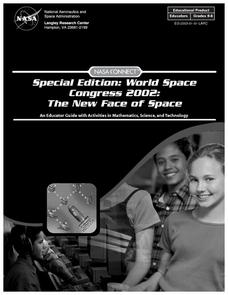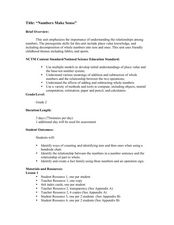Curated OER
Winding Up
Pupils make simple drawings to show how winding machines work. They gain knowledge of what winding mechanisms are and how they work and are assembled. This lesson is divided into whole group, individual and small group activities.
Curated OER
Solid Earth Socratic Questions
Students participate in a whole class discussion to relate what they know about earthquakes to the processes of plate tectonics. They respond to prompts that lead them to conclusions about the layers of the earth.
Curated OER
Neanderthals on Trial
Students examine a drawing of a Neanderthal artifact that was found in Solvenia in 1996. They attempt to identify the artifact in small groups, and present their ideas to the whole class. They discover what scientists believe the...
Curated OER
Explore the Effects of Immigration
Students explore the effects of immigration on the immigrants and on society as a whole. They will record the experiences of specific immigrant groups using an E-sheet. Groups present a summary of what they learned about their ethnic...
Curated OER
Get Ready, Get Set, Hibernate
Students match each body part or idea from a work bank about methods of animal adaptations for winter survival. They observe as the first one, food is covered with the whole class before completing the rest of the diagram. They discuss...
Curated OER
Special Edition: World Space Congress 2002: The New Face of Space
Students experience and study how space offers expanding resources for commerce, science, technology and education. They view how advances in space can and do improve life on Earth. Each student views a geological exploration within this...
Curated OER
You've Got Rhythm
Students study the rhythm value of a half note, quarter note, whole note, and eighth note. They stamp a rhythm pattern and create a clay animation which demonstrates note value.
Curated OER
Characteristics of Living Things
Student use the scientific method to experiment with worms. In this characteristics of living things lesson, students predict and examine the reactions of worms to dry and wet soil. Students share their findings.
Curated OER
2.0 "Water Is Life" Global Water Awareness Mini-Unit (Grades3-5)
Students study the amount of potable water on the Earth. In this water lesson, students examine the amount of potable water as compared to all the water on the Earth. They discuss why many parts of the world do not have access to good...
Curated OER
History of the X-Ray
Seventh graders discuss the history of the x-ray machine. For this social science lesson, 7th graders understand how a x-ray machine works. Students recognize that there have been many improvements to the x-ray machine over the...
Curated OER
Dietary Fiber
Students examine the different types of fiber and their benefits. In this investigative lesson plan students find good sources of fiber in different foods.
Institute for Teaching through Technology and Innovative Practices
The Right Number of Elephants
How can you tell if a number of items is reasonable? Combine math and language arts with a fun lesson based on Jeff Shepard's The Right Number of Elephants. After reading the book, kids discuss amounts of other items and create...
Education Development Center
Adding Fractions with Unlike Denominators
If the fractions don't have a common denominator, make them have one. Learners first read and analyze a conversation of pupils trying to add 2/5 and 1/2. They compare the process of adding fractions to the process of adding quantities...
DiscoverE
Build a Straw Bridge
Build teamwork skills while building a bridge. Scholars work together in groups to create a bridge out of 20 straws and tape. There is a minimum span length of 25 centimeters, but otherwise, let creativity run wild.
Curated OER
Frindle: A Guiding Reading Unit
Guide your class through a reading of the popular children's book, Frindle, with this comprehensive literature unit. Starting with a brief introduction to the guided reading process, the class goes on to read the story two chapters...
K5 Learning
The Astronomy Project
A passage about an astronomy lesson may leave readers starstruck. Fifth graders read about a class's exploration into the makeup of the galaxy and its constellations before answering six questions about the terms and vocabulary...
ProCon
Standardized Tests
Does the use of standardized testing improve American education? Scholars dive into the issue as they prepare to discuss the debate topic with their classmates. After reviewing the pros and cons, they watch videos to help them arrive at...
PBS
Cloud Clues
It's cloudy with a good chance of learning! An inquiry-based lesson begins with an exploration of transparent, translucent, and opaque materials. Young scientists then connect their learning to the different cloud types as they take the...
Curated OER
Making Blood!
students research blood's components, and use their math skills to recreate a model of whole blood using commonly found food items.
Curated OER
Numbers Make Sense
Second graders explore number values by completing estimation problems in class. In this place value lesson, 2nd graders identify the use of decimals in numbers and how they relate to fractions or parts of a whole. Students utilize flash...
Curated OER
By Golly By Gum
Students identify the different steps in the scientific method. In this inquiry lesson, students determine the mass of the gum after chewing it for sometime. They explain what happens to the lost mass.
Curated OER
Micro-organisms
Students learn what a micro-organism is. In this micro-organism lesson, students understand that micro-organisms may be too small to see. Students learn microorganisms could be bacteria, fungi, something beneficial or a harmful microbe....
Curated OER
Forest Ecology
Learners examine the different plants and animals in British Columbia. In this forest ecology lesson students explore how ecosystems work, classify animals and investigate food webs and chains.
Curated OER
What is a Magnet?
In this magnet worksheet, students review what makes up matter, how electromagnets are made, and how compasses work. This worksheet has 6 fill in the blank and 2 short answer questions.























